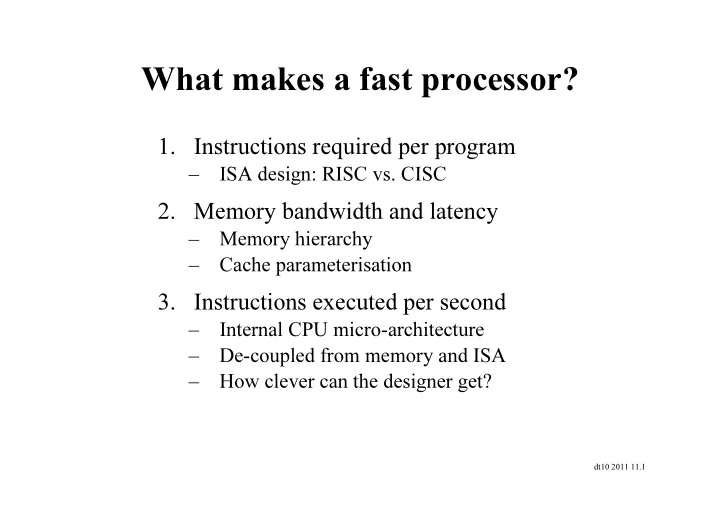

What makes a fast processor? 1. Instructions required per program – ISA design: RISC vs. CISC 2. Memory bandwidth and latency – Memory hierarchy – Cache parameterisation 3. Instructions executed per second – Internal CPU micro-architecture – De-coupled from memory and ISA – How clever can the designer get? dt10 2011 11.1
Pipelining: The search for GHz • Early CPUs: single-cycle – Lets just make it work; who cares about fast? – Entire fetch-execute-retire process = 1 cycle/instruction – Built from discrete components or drawn by hand • Micro-processors: multiple cycles per instruction – Can we make this run faster than 1MHz? – Fetch; then execute; then retire = 3+ cycles/instruction – Designed using first Electronic Design Automation tools • 1990s: the pipeline is king – We expect to be running at 10GHz by 2000... – Multiple execute cycles; 20-30+ cycles/instruction – No single person understands the whole CPU... dt10 2011 11.2
Example: technology in PS2 and PS3 Source: Microprocessor Report: Feb 14, 2005 dt10 2011 11.3
So is pipelining worth it? • Yes! Just don’t go overboard – All processors in use today are pipelined – What clock rate is the CPU in your phone? • Pipelining is not just for performance – Power advantages due to reduced glitches • Two main difficulties associated with pipelining 1. MUST: Make sure processor still operates correctly 2. TRY TO: Balance increased clock rate vs CPU stalls dt10 2011 11.4
Pipelining (3 rd Ed: p.370-454, 4 th Ed: p.330-409) • split up combinational circuit by pipeline registers • benefits – shorter cycle time, assembly-line parallelism – reduce power consumption by reducing glitches • pipelined processor design – balance delay in different stages – resolve data and control dependencies f g h dt10 2011 11.5
Single-cycle datapath Mux + ∗ 4 4 + Icache Regfile ALU Mux Mux Dcache Mux PC 16 32 Sign extend dt10 2011 11.6
Pipelined datapath Mux + ∗ 4 4 + Icache Regfile ALU Mux Mux Dcache Mux PC 16 32 Sign extend dt10 2011 11.7
R-type instruction: fetch Mux + ∗ 4 4 At the end of the fetch + cycle, the instruction is held in this pipeline register Icache Regfile ALU Mux Mux Dcache Mux PC 16 32 Sign extend dt10 2011 11.8
R-type instruction: register read Mux + ∗ 4 4 Now the two register + values are held here Icache Regfile ALU Mux Mux Dcache Mux PC 16 32 Sign extend dt10 2011 11.9
R-type instruction: execution Mux The ALU + ∗ 4 result is put 4 + here Icache Regfile ALU Mux Mux Dcache Mux PC 16 32 Sign extend dt10 2011 11.10
R-type instruction: memory Mux + ∗ 4 4 + The ALU result is just copied along Icache Regfile ALU Mux Mux Dcache Mux PC 16 32 Sign extend dt10 2011 11.11
R-type instruction: write-back Mux + ∗ 4 4 The result is written + into a register Icache Regfile ALU Mux Mux Dcache Mux PC 16 32 Sign extend dt10 2011 11.12
Writing the correct register Mux + ∗ 4 4 The register number is saved + for three clock cycles, until the data is ready. Icache Regfile ALU Mux Dcache Mux PC 16 32 Mux dt10 2011 11.13
Control signals Mux + ∗ 4 4 + RegWrite RegDst MemtoReg PCSrc ALUSrc ALUFunc MemRead MemWrite Icache Regfile ALU Mux Dcache Mux PC 16 32 Mux dt10 2011 11.14
Pipelined control Mux + ∗ 4 4 + Icache Regfile ALU Mux Dcache Mux PC 16 32 Mux dt10 2011 11.15
Performance issues • longest delay determines clock period of processor – different instruction types use different sets of stages – critical path is load instruction: uses all stages load = instr. mem. ► reg. file ► ALU ► data mem. ► reg. file add = instr. mem. ► reg. file ► ALU ► data mem. ► reg. file • can’t vary clock period for each instruction • violates design principle – making the common case fast • most common solution: pipelining – other solutions exist: e.g. GALS, self-timed logic dt10 2011 11.16
Pipelining analogy • pipelined laundry: overlapping execution – parallelism improves performance • 4 loads: – speedup = 8/3.5 = 2.3 • non-stop: – Speedup = 2n/0.5n + 1.5 ≈ 4 = number of stages dt10 2011 11.17
MIPS pipeline • Five stages, one step per stage 1. IF: Instruction fetch from memory 2. ID: Instruction decode & register read 3. EX: Execute operation or calculate address 4. MEM: Access memory operand 5. WB: Write result back to register dt10 2011 11.18
Pipeline performance: analysis • assume time for stages is – 100ps for register read or write – 200ps for other stages • compare pipelined datapath with single-cycle datapath Instr. Type Instr. fetch Reg. read ALU op. Data mem. Reg. write Total time (IF) (ID) (EX) (MEM) (WB) lw 200ps 100 ps 200ps 200ps 100 ps 800ps sw 200ps 100 ps 200ps 200ps 700ps R-format 200ps 100 ps 200ps 100 ps 600ps beq 200ps 100 ps 200ps 500ps dt10 2011 11.19
Pipeline performance: comparison Single-cycle (T c = 800ps) Pipelined (T c = 200ps) dt10 2011 11.20
Pipeline speedup • assume: all stages are balanced – all take the same time – time between instructions pipelined time between instructions nonpipelined = number of stages • if stages are not balanced, speedup is less • speedup due to increased throughput – latency (time for each instruction) does not decrease – pipelining almost always increases latency a little... dt10 2011 11.21
Pipelining and ISA design • MIPS ISA designed for pipelining • all instructions are 32-bits – Easier to fetch and decode in one cycle – contrast x86: 1-byte to 17-byte instructions • few and regular instruction formats – decode and read registers in one step • load/store addressing – calculate address in 3 rd stage, access memory in 4 th stage • alignment of memory operands – memory access takes only one cycle dt10 2011 11.22
Recommend
More recommend